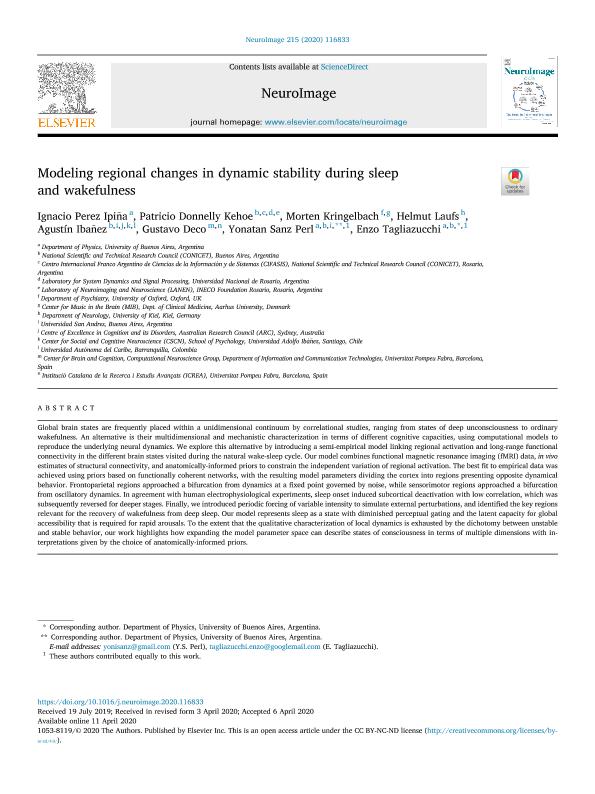Mostrar el registro sencillo del ítem
dc.contributor.author
Perez Ipiña, Ignacio Martin

dc.contributor.author
Donnelly Kehoe, Patricio Andres

dc.contributor.author
Kringelbach, Morten
dc.contributor.author
Laufs, Helmut
dc.contributor.author
Ibañez, Agustin

dc.contributor.author
Deco, Gustavo
dc.contributor.author
Sanz Perl Hernandez, Yonatan

dc.contributor.author
Tagliazucchi, Enzo Rodolfo

dc.date.available
2021-09-10T16:35:14Z
dc.date.issued
2020-07-15
dc.identifier.citation
Perez Ipiña, Ignacio Martin; Donnelly Kehoe, Patricio Andres; Kringelbach, Morten; Laufs, Helmut; Ibañez, Agustin; et al.; Modeling regional changes in dynamic stability during sleep and wakefulness; Elsevier; Journal Neuroimag; 215; 116833; 15-7-2020; 1-13
dc.identifier.issn
1053-8119
dc.identifier.uri
http://hdl.handle.net/11336/140103
dc.description.abstract
Global brain states are frequently placed within a unidimensional continuum by correlational studies, ranging from states of deep unconsciousness to ordinary wakefulness. An alternative is their multidimensional and mechanistic characterization in terms of different cognitive capacities, using computational models to reproduce the underlying neural dynamics. We explore this alternative by introducing a semi-empirical model linking regional activation and long-range functional connectivity in the different brain states visited during the natural wake-sleep cycle. Our model combines functional magnetic resonance imaging (fMRI) data, in vivo estimates of structural connectivity, and anatomically-informed priors to constrain the independent variation of regional activation. The best fit to empirical data was achieved using priors based on functionally coherent networks, with the resulting model parameters dividing the cortex into regions presenting opposite dynamical behavior. Frontoparietal regions approached a bifurcation from dynamics at a fixed point governed by noise, while sensorimotor regions approached a bifurcation from oscillatory dynamics. In agreement with human electrophysiological experiments, sleep onset induced subcortical deactivation with low correlation, which was subsequently reversed for deeper stages. Finally, we introduced periodic forcing of variable intensity to simulate external perturbations, and identified the key regions relevant for the recovery of wakefulness from deep sleep. Our model represents sleep as a state with diminished perceptual gating and the latent capacity for global accessibility that is required for rapid arousals. To the extent that the qualitative characterization of local dynamics is exhausted by the dichotomy between unstable and stable behavior, our work highlights how expanding the model parameter space can describe states of consciousness in terms of multiple dimensions with interpretations given by the choice of anatomically-informed priors.
dc.format
application/pdf
dc.language.iso
eng
dc.publisher
Elsevier

dc.rights
info:eu-repo/semantics/openAccess
dc.rights.uri
https://creativecommons.org/licenses/by-nc-sa/2.5/ar/
dc.subject
Whole-Brain Models
dc.subject
Neuroscience
dc.subject
Non-linear dynamics
dc.subject
Human Sleep Stages
dc.subject.classification
Otras Ciencias de la Salud

dc.subject.classification
Ciencias de la Salud

dc.subject.classification
CIENCIAS MÉDICAS Y DE LA SALUD

dc.title
Modeling regional changes in dynamic stability during sleep and wakefulness
dc.type
info:eu-repo/semantics/article
dc.type
info:ar-repo/semantics/artículo
dc.type
info:eu-repo/semantics/publishedVersion
dc.date.updated
2021-09-07T19:20:01Z
dc.journal.volume
215
dc.journal.number
116833
dc.journal.pagination
1-13
dc.journal.pais
Estados Unidos

dc.description.fil
Fil: Perez Ipiña, Ignacio Martin. Universidad de Buenos Aires. Facultad de Ciencias Exactas y Naturales. Departamento de Física; Argentina
dc.description.fil
Fil: Donnelly Kehoe, Patricio Andres. Consejo Nacional de Investigaciones Científicas y Técnicas. Centro Científico Tecnológico Conicet - Rosario. Centro Internacional Franco Argentino de Ciencias de la Información y de Sistemas. Universidad Nacional de Rosario. Centro Internacional Franco Argentino de Ciencias de la Información y de Sistemas; Argentina
dc.description.fil
Fil: Kringelbach, Morten. University of Oxford; Reino Unido. University Aarhus; Dinamarca
dc.description.fil
Fil: Laufs, Helmut. University of Kiel; Alemania
dc.description.fil
Fil: Ibañez, Agustin. Consejo Nacional de Investigaciones Científicas y Técnicas. Oficina de Coordinación Administrativa Houssay. Instituto de Neurociencia Cognitiva. Fundación Favaloro. Instituto de Neurociencia Cognitiva; Argentina. Universidad de San Andrés; Argentina. Australian Research Council; Australia. Universidad Adolfo Ibañez; Chile. Universidad Autónoma del Caribe; Colombia
dc.description.fil
Fil: Deco, Gustavo. Universitat Pompeu Fabra; España
dc.description.fil
Fil: Sanz Perl Hernandez, Yonatan. Universidad de Buenos Aires; Argentina. Consejo Nacional de Investigaciones Científicas y Técnicas; Argentina. Universidad de San Andrés; Argentina
dc.description.fil
Fil: Tagliazucchi, Enzo Rodolfo. Consejo Nacional de Investigaciones Científicas y Técnicas; Argentina. Universidad de Buenos Aires. Facultad de Ciencias Exactas y Naturales. Departamento de Física; Argentina
dc.journal.title
Journal Neuroimag

dc.relation.alternativeid
info:eu-repo/semantics/altIdentifier/url/https://linkinghub.elsevier.com/retrieve/pii/S1053811920303207
dc.relation.alternativeid
info:eu-repo/semantics/altIdentifier/doi/http://dx.doi.org/10.1016/j.neuroimage.2020.116833
Archivos asociados
